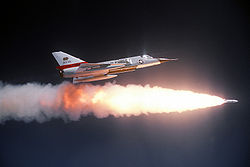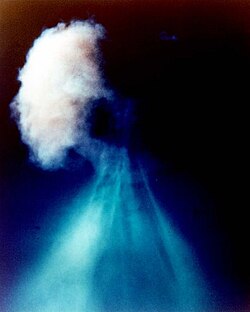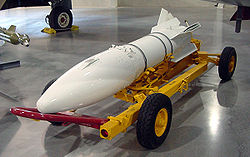This is an old revision of this page, as edited by NaomiAmethyst (talk | contribs) at 06:18, 24 July 2007 (Undid revision 146706770 by Adam1not (talk) - Vandal). The present address (URL) is a permanent link to this revision, which may differ significantly from the current revision.
Revision as of 06:18, 24 July 2007 by NaomiAmethyst (talk | contribs) (Undid revision 146706770 by Adam1not (talk) - Vandal)(diff) ← Previous revision | Latest revision (diff) | Newer revision → (diff)

The Douglas Genie (MB-1 Ding-Dong, AIR-2) was an unguided air-to-air rocket with a 1.5kt W25 nuclear warhead. It was deployed by the United States Air Force and Royal Canadian Air Force (from 1 February 1968, Canadian Forces) from the late 1950s to the 1980s during the Cold War. Production ended in 1962 after over 1000 were produced, with some related training and test derivatives occurring later.
Development
The interception of Soviet bombers was a major military preoccupation of the late 1940s and 1950s. The revelation in 1947 that the Soviet Union had produced a reverse-engineered copy of the Boeing B-29 Superfortress, the Tupolev Tu-4 (NATO reporting name 'Bull'), which could reach the continental United States in a one-way attack, followed by the Soviets developing the atomic bomb in 1949, produced considerable anxiety.
Against high-speed bombers, the World War II-vintage fighter armament of machine guns and cannon was inadequate. The use of large volleys of unguided rockets was not much more satisfactory, and true air-to-air missiles were in their infancy. In 1954 Douglas Aircraft began a program to investigate the possibility of a nuclear-armed air-to-air weapon. To ensure simplicity and reliability, the weapon would be unguided, the large blast radius making relative inaccuracy mostly irrelevant.
The resultant weapon carried a 1.5-kiloton W25 nuclear warhead and was powered by a Thiokol SR49-TC-1 solid-fuel rocket engine of 162 kN (36,500 lbf) thrust. It had a range of slightly under 10 km (6 mi). Targeting, arming, and firing of the weapon were coordinated by the launch aircraft's fire-control system. Detonation was by time-delay fuse, although the fuse would not arm the warhead until engine burn-out, to give the launch aircraft time to turn and escape. Lethal radius of the blast was estimated to be about 300 meters (1,000 ft).
The first test firings (of inert rounds) took place in 1956, and the weapon entered service with the designation MB-1 in 1957. The popular name was Genie, but it was often nick-named 'Ding-Dong.' About 3,150 rounds were produced before production ended in 1963. In 1962 the weapon was redesignated AIR-2A Genie. Many rounds were upgraded with improved, longer-duration rocket motors, the upgraded weapons sometimes known (apparently only semi-officially) as AIR-2B. An inert training round, originally MB-1-T and later ATR-2A, was also produced in small numbers.
A live Genie was detonated only once, in Operation Plumbbob on 19 July 1957. It was fired by an F-89J over Yucca Flats Nuclear Test Site at an altitude of 4,500 m (15,000 ft). A group of USAF officers volunteered to stand underneath the blast to prove that the weapon was safe for use over populated areas. Whether this affected the health of the officers is unknown.
The Genie was cleared for being carried on the F-89 Scorpion, F-101B Voodoo, F-106 Delta Dart, and F-104 Starfighter in U.S. service. However, the Starfighter never carried it in operational service. Convair offered an upgrade of the F-102 Delta Dagger that would have been Genie-capable, but it was not adopted. Operational use of the Genie was discontinued in 1988 with the retirement of the F-106 interceptor.
The only non-U.S. user was Canada, whose CF-101 Voodoos carried Genies until 1984 via a dual-key arrangement where the missiles were kept under American custody, and released to Canada under circumstances requiring their use. The RAF briefly considered the missile for use on the English Electric Lightning.
The F-89J that was used to launch the only live test is on static display at the Montana Air National Guard in Great Falls, MT.

Specifications (AIR-2A)
- Length: 2.95 m (9 ft 8 in)
- Diameter: 0.44 m (17.5 in)
- Wingspan: 1.02 m (3 ft 4 in)
- Launch weight: 373 kg (822 lb)
- Speed: Mach 3.3
- Range: 9.6 km (6 m)
- Guidance: Inertial (None)
- Warhead: W25 nuclear fission, 1.5 kiloton yield
- Date deployed: 1957
- Date retired: 1985
Used with MF-9 Transport Trailer
Survivors
| This section needs expansion. You can help by making an edit requestadding to it . |
Below is a list of museums which have a Genie rocket in their collection:
- Air Force Armament Museum, Eglin Air Force Base, Florida
- Hill Aerospace Museum, Ogden, Utah
- Museum of Aviation at Robins Air Force Base, Georgia ATR-2N with MF-9 trailer
- National Museum of the United States Air Force, Wright-Patterson Air Force Base, Ohio
- Oregon Military Museum at Camp Withycombe, Clackamas, Oregon
- Western Canada Aviation Museum, Winnipeg, Manitoba, Canada
See also
References
| Aviation lists | |
|---|---|
| General | |
| Military | |
| Accidents / incidents | |
| Records | |